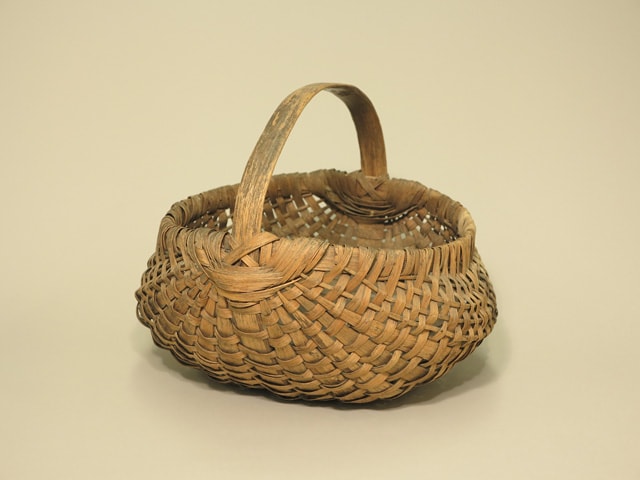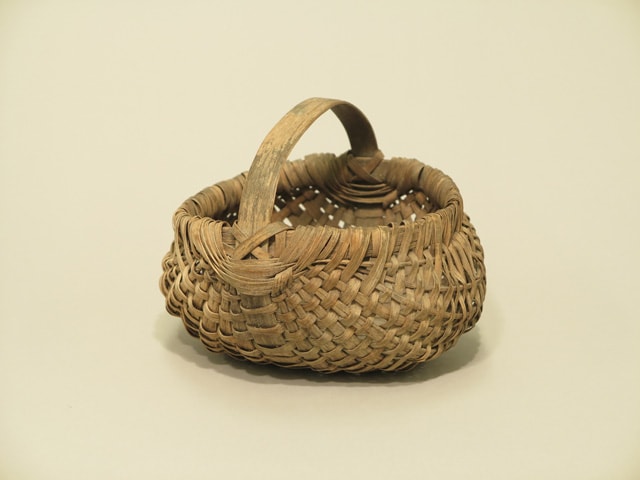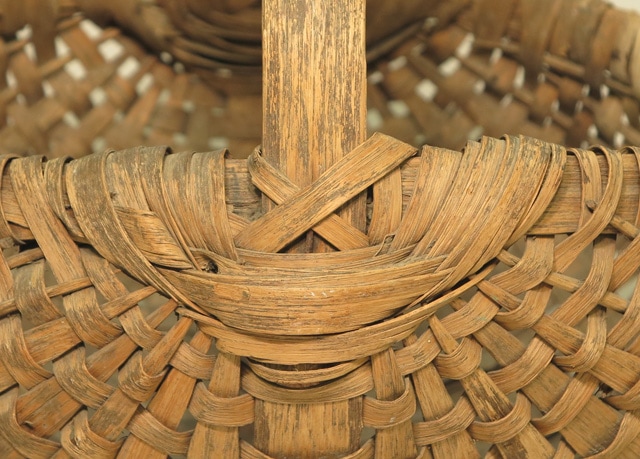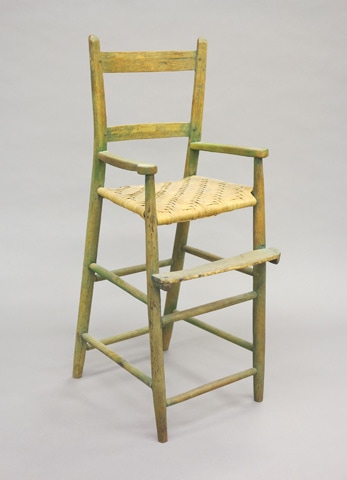
The MSV retains examples by many of the Valley’s great basketmaking dynasties—the Nicholsons, Prices, and Cooks, among others—but the Museum’s strongest holdings are made up of baskets and other objects from the Day family of Shenandoah County.
The Treasures from the Vault program series concluded in June with an in-depth look at Valley basketmakers and their craft. At one time, baskets were integral to everyday life in the Valley. The Valley’s people used baskets to collect food, take goods to market, carry their tools—really any purpose you can think of.
The MSV retains examples by many of the Valley’s great basketmaking dynasties—the Nicholsons, Prices, and Cooks, among others—but the Museum’s strongest holdings are made up of baskets and other objects from the Day family of Shenandoah County. For this month’s post, I thought we might explore the woven wares of this particular family.

Fig 1. Rib basket attributed to a member of the Day family, late 1800s or early 1900s, Shenandoah County, VA. Oak. Collection of the Museum of the Shenandoah Valley, 2001.0013.191.
Basketmakers rarely signed their work, meaning historians often rely on a combination of oral histories and specific characteristics to identify individual pieces. The clues to identifying Day family baskets in the MSV collection lie with the collector-dealer couple Mildred Helsley and her late husband Bruce (1919-2000). For many years, the Helsleys operated an antique shop in Toms Brook in Shenandoah County. The Helsleys’ unique position allowed them to record the histories of many of the objects they handled, including baskets they added to their own private collection.

Fig 2. Flyer for the Helsley’s antique shop in Toms Brook, Virginia, August 1989. Collection of the Museum of the Shenandoah Valley, Archives Collection.
Over time, the Helsleys expanded their collection to include Valley textiles, furniture, pottery, and of course, baskets. Bruce Helsley was a cousin to the Days, ensuring they purchased baskets and other objects directly from the Day basketmaker of their time, Oliver L. Day (1906-2002). For example, a note attached to one ovoid splint basket reveals that the Helsleys purchased it from Day in September 1981. His mother Julia Dorcas Turner Day (1885-1957) used it as her laundry basket during her lifetime.

Fig 3. Splint basket attributed to a member of the Day family, possibly Osceala Day (1880-1962), early-to-mid 1900s, Shenandoah County, VA. Oak. Collection of the Museum of the Shenandoah Valley, 2001.0013.209.
The MSV acquired the Helsleys’ collection in 2005. The Museum not only inherited objects, but the lifelong accumulation of knowledge behind them. Some of that knowledge is readily available in Rachel Nash Law and Cynthia W. Taylor’s still-groundbreaking book: Appalachian White Oak Basketmaking: Handing Down the Basket (1991). The authors interviewed Mildred and Bruce Helsley in 1991, and many baskets now in the MSV collection can be found amongst the book’s pages.

Fig 4. Mildred “Mickie” Helsley in the living room of her Woodstock home, 1990s. Collection of the Museum of the Shenandoah Valley, Archives Collection.
Oliver Day was the most recent member to pick up the tradition, but his grandfather Thomas Benton Day (1845-1920) is actually the earliest documented basketmaker in the family. Thomas was born and likely lived most of his life in the Columbia Furnace area of Shenandoah County. According to Oliver, Thomas made his living by making baskets and bottoming chairs.[i]
Like many craftsmen of his era, Thomas was not listed as a basketmaker in officials records. Records like the U.S. Census instead identify him variously as a farmer, day laborer, and even “no occupation” during his lifetime. Farming was often the primary occupation of Valley artisans. Their craft skills developed to aid their farm work, serve as an extra source of income, act as a useful hobby, or a combination of the three.
Two objects in the MSV collection might date to Thomas’ time period. The first is a softwood rocking chair covered in green milk paint.

Fig 5. Slat-back rocking chair possibly by Thomas Benton Day (1845-1920), late 1800s or early 1900s, Columbia Furnace area, Shenandoah County, VA. Unidentified woods under milk paint, oak. Collection of the Museum of the Shenandoah Valley, 2001.0013.755.
A pencil inscription on one of the rockers in Mildred Helsley’s hand identifies Thomas B. Day as the original owner—and possibly maker. While not definitive proof, the chair has features that fit a basketmaker’s skill set. The chair is not lathe turned. Instead, the chair’s unevenly-cut stiles, arm supports, and slats show evidence of being shaven down with a draw knife. Basketmakers commonly used draw knives to trim large billets of wood down into smaller, workable strips.

Fig 6. Detail of the stiles and slats on the rocking illustrated in Figure 5.
On a smaller scale—but much more important—is an L-shaped wrought iron basketmaker’s die owned by Thomas B. Day.

Fig 7. Basketmaker’s die owned by Thomas Benton Day (1845-1920), probably late 1800s, Columbia Furnace area, Shenandoah County, VA. Wrought iron. Collection of the Museum of the Shenandoah Valley, 2001.0013.764.4.
Basketmakers used dies to dress pieces of oak to shape for various types of baskets. The three screw holes at the bottom allowed a basketmaker to secure the die to a bench or other surface. After starting a piece of oak through the upper holes and/or slits, a basketmaker then used a pair of pliers to pull the wood through on the other side. The sharp, beveled edges cut off excess chaff as the wood moved.
Multiple, graduated slits in the die allowed Day basketmakers to shape the wood into increasingly smaller pieces until they reached the final, desired diameter. The Day family die is more uncommon than most, in that it can shape several types of wood strips.

Fig 8. Detail of the basketmaker’s die illustrated in Figure 7.
The horizontal slits made flat splints (or splits), used in splint baskets that often utilize simple over-under woven patterns. The laundry basket mentioned earlier (Fig. 3) is a good example of a Day family splint basket.
The round holes on the die can shape either ribs or rods. In rib baskets, multiple ribs are set into the same central point at intervals to create a rounded framework. Basketmakers then weave flat splints through the ribs to close the form.

Fig 9. Rib basket attributed to a member of the Day family, late 1800s or early 1900s, Shenandoah County, VA. Oak. Collection of the Museum of the Shenandoah Valley, 2001.0013.215.
The use of wide, lapped splints as lashings around the handle—obscuring the “X-shaped” lashing underneath—is a characteristic common to Day family rib baskets.

Fig 10. Detail of the lashings on the basket illustrated in Figure 9.
Rod baskets, on the other hand, incorporate the round pieces in a different way. Similar to a splint basket, basketmakers weave round rods in over-under patterns through a series of vertical stakes. The rod basket below is a rare example with its attached lid.

Fig 11. Rod basket with lid attributed to a member of the Day family, late 1800s or early 1900s, Shenandoah County, VA. Probably oak, possibly willow or reed. Collection of the Museum of the Shenandoah Valley, 2001.0013.183.
Thomas B. Day’s tools and talents allowed him to make baskets of many different shapes and sizes. Coal baskets, for example, are one of the most common Day family forms. Thomas’ grandson Oliver noted that baskets of this type could serve any purpose, but they were nevertheless always called coal baskets.

Fig 12. Coal basket attributed to a member of the Day family, possibly Thomas Benton Day (1845-1920) or Osceala Day (1880-1962), late 1800s or early 1900s, Shenandoah County, VA. Oak. Collection of the Museum of the Shenandoah Valley, 2001.0013.204.
The Days shipped this type of basket as far away as Paw Paw, West Virginia, on rail lines.[ii] At twenty-two inches in diameter, the above coal basket is one of the largest in the MSV collection. Dark stains in the center of basket might confirm the basket’s history of carrying coal, or perhaps tree bark used in tanning.

Fig 13. Detail of the interior of the coal basket illustrated in Figure 12.
The Day family tradition continued with both Thomas’ son Osceala Day (1880-1962) and grandson Oliver L. Day. Little is known about Osceala, but Oliver claimed he learned the trade directly from his grandfather Thomas. In addition to making traditional oak baskets like those of his forebears, Oliver also turned to newer materials and techniques as time passed. For example, a drought in the 1930s that killed many oak trees in Shenandoah County forced him to purchase round reed for basketmaking.[iii]
Oliver also frequently wove splint seats for chairs. In some instances, he replaced broken seats on older chairs. A high chair on view in the 1930s Kitchen vignette at the MSV might bear a seat replaced by him.

Fig 14. High chair with seat possibly rewoven by Oliver L. Day (1906-2002), late 1800s (chair) and early-to-mid 1900s (seat), Shenandoah County, VA. Oak, possibly ash, paint. Collection of the Museum of the Shenandoah Valley, 2001.0013.034.

Fig 15. Detail of the seat of the high chair illustrated in Figure 14.
In other cases, Oliver collaborated with other craftsmen to weave seats for newly-finished chairs. One rocking chair in the MSV collection with a frame made by Samuel G. “Sam” Wagner (1857-1942) of Maurertown retains an oak splint seat thought by the Helsleys to be Day’s work. The rocker is typical of many chairs Valley women used for tasks like sewing. The low seat provided easy access to tools and/or materials resting on the floor beside the chair.

Fig 16. Rocking chair with frame attributed to Samuel G. “Sam” Wagner (1857-1942) and seat attributed to Oliver L. Day (1906-2002), about 1916, Maurertown, Shenandoah County, VA. Walnut, oak. Collection of the Museum of the Shenandoah Valley, 2001.0013.022. Photo by Ron Blunt.

Fig 17. Detail of the seat of the rocking chair illustrated in Figure 13.
Oliver Day passed away in 2002, emphasizing the need to document and record the stories behind objects before that knowledge is lost. Much more work needs to be done on this intriguing subset of the MSV collection. You can help! Do you have any baskets or chairs by the Day family or knowledge about them? I would be happy to hear from you at npowers@themsv.org. Until then, I look forward to sharing more discoveries with you as this story continues to “weave” itself together!
Photos by Nick Powers unless otherwise specified.
[i] Law, Rachel Nash and Cynthia W. Taylor, Appalachian White Oak Basketmaking: Handing Down the Basket (Knoxville, TN: The University of Tennessee Press, 1991), 56.